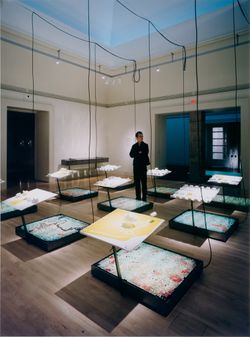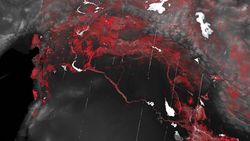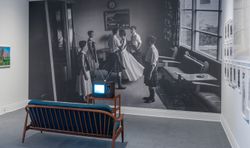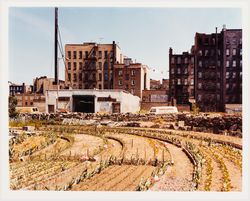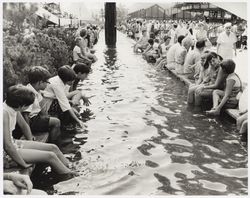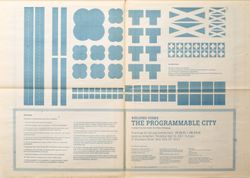archives
Niveau de description archivistique:
Fonds
Fonds Zdzislaw Przygoda
AP126
Résumé:
Le Fonds Zdzislaw Przygoda (Sir Casimir Gzowski Memorial) est composé de deux dessins, d'une photographie et de documents textuels, principalement de la correspondance, relatifs au projet de construire un monument commémoratif à Toronto à la mémoire de l'ingénieur polonais Sir Casimir Gzowski (1813-1898). Les documents produits et colligés par Zdzislaw Przygoda, vice-président exécutif du Sir Casimir Gzowski Memorial Centennial Committee, nous renseignent sur l'évolution du projet.
1963-1967
Fonds Zdzislaw Przygoda
Actions:
AP126
Résumé:
Le Fonds Zdzislaw Przygoda (Sir Casimir Gzowski Memorial) est composé de deux dessins, d'une photographie et de documents textuels, principalement de la correspondance, relatifs au projet de construire un monument commémoratif à Toronto à la mémoire de l'ingénieur polonais Sir Casimir Gzowski (1813-1898). Les documents produits et colligés par Zdzislaw Przygoda, vice-président exécutif du Sir Casimir Gzowski Memorial Centennial Committee, nous renseignent sur l'évolution du projet.
archives
Niveau de description archivistique:
Fonds
1963-1967
Surface du quotidien : La pelouse en Amérique montre la pelouse comme symbole de la vie domestique, espace public de représentation, agent économique et icône de l’Amérique. Les pavillons des lotissements de banlieue, les sièges d’entreprise établis en milieu suburbain et la Maison Blanche ont une chose en commun : tous ces bâtiments sont entourés d’une pelouse – une(...)
Salles principales, salle octogonale et vitrines
16 juin 1998 au 8 novembre 1998
Surface du quotidien : la pelouse en Amérique
Actions:
Description:
Surface du quotidien : La pelouse en Amérique montre la pelouse comme symbole de la vie domestique, espace public de représentation, agent économique et icône de l’Amérique. Les pavillons des lotissements de banlieue, les sièges d’entreprise établis en milieu suburbain et la Maison Blanche ont une chose en commun : tous ces bâtiments sont entourés d’une pelouse – une(...)
Salles principales, salle octogonale et vitrines
archives
Niveau de description archivistique:
Fonds
Fonds Álvaro Siza
AP178
Description:
The Álvaro Siza fonds documents the architectural work of Portuguese architect Álvaro Siza. Records in this fonds document Siza’s projects from 1958-2012, including built and unbuilt designs. A collaborative project was established between the Canadian Centre for Architecture (CCA), Fundação de Serralves, and Fundação Calouste Gulbenkian to allow for international research and access to the archive. The archive is shared by the three institutions with each institution holding different projects while collaborating on the descriptive work and increasing the visibility of the archive. The holdings at both the Fundação de Serralves and Fundação Calouste Gulbenkian focus on Siza’s Portuguese projects, while the portion of the archive held by the CCA mainly includes Siza’s projects abroad. All three institutions are committed to describing the archive and making it accessible for scholarly research. The processing of the Siza archive held by the CCA has been divided into four phases to allow for access to parts of the archive while still in process. For the first, second, and third phases, the processing archivist has described the projects from the fifties, sixties, and seventies, as well as projects for the IBA competition in Berlin, urban renewal projects in The Hague from the eighties, urban plans, museums, and individual houses between 1980 and 2000. The processing archivist has also described approximately 203 sketchbooks. Many of these sketchbooks include sketches related to architectural projects which were processed. The complete list of projects processed by the CCA to date can be found in series AP178.S1. The bulk of the Álvaro Siza fonds is arranged in Series AP178.S1, which contains documentation for over 200 of Siza’s architectural projects. Records in this archive are predominantly from 1970 to 2000. Series AP178.S1 mainly contains conceptual, design development, presentation, and working drawings. Also included are photographic materials, models, born digital records, and textual documentation, which include correspondence, project proposals, and notes. The architect’s creative process is captured in 282 sketchbooks arranged in Series AP178.S2. In all there are approximately 60 000 drawings, 3000 folders of textual documentation, 9.46 linear meters of photographs and negatives, 6,545 slides, 250 CD-ROMS, 101 floppy disks, and 371 models that document the architectural activities of Siza and his office. Among the drawings are sketches by Siza on various items, such as napkins, receipts, envelopes, or on the back of working drawings. The fonds contains several types of architectural projects including residential buildings, museums, universities, urban plans, offices, and city restorations. Of particular significance are the sketchbooks, comprised of sketches for architectural projects, Siza’s travels, people, and animals as well as notes and draft letters. The sketchbooks are organized in chronological order, starting in the late 1970’s to the beginning of the 2000’s. Locations, notes, and dates have also been identified on the front of each sketchbook along with the sketchbook number. The sketchbooks provide a unique perspective of Siza’s use of drawing as part of his work process.
1958-2002
Fonds Álvaro Siza
Actions:
AP178
Description:
The Álvaro Siza fonds documents the architectural work of Portuguese architect Álvaro Siza. Records in this fonds document Siza’s projects from 1958-2012, including built and unbuilt designs. A collaborative project was established between the Canadian Centre for Architecture (CCA), Fundação de Serralves, and Fundação Calouste Gulbenkian to allow for international research and access to the archive. The archive is shared by the three institutions with each institution holding different projects while collaborating on the descriptive work and increasing the visibility of the archive. The holdings at both the Fundação de Serralves and Fundação Calouste Gulbenkian focus on Siza’s Portuguese projects, while the portion of the archive held by the CCA mainly includes Siza’s projects abroad. All three institutions are committed to describing the archive and making it accessible for scholarly research. The processing of the Siza archive held by the CCA has been divided into four phases to allow for access to parts of the archive while still in process. For the first, second, and third phases, the processing archivist has described the projects from the fifties, sixties, and seventies, as well as projects for the IBA competition in Berlin, urban renewal projects in The Hague from the eighties, urban plans, museums, and individual houses between 1980 and 2000. The processing archivist has also described approximately 203 sketchbooks. Many of these sketchbooks include sketches related to architectural projects which were processed. The complete list of projects processed by the CCA to date can be found in series AP178.S1. The bulk of the Álvaro Siza fonds is arranged in Series AP178.S1, which contains documentation for over 200 of Siza’s architectural projects. Records in this archive are predominantly from 1970 to 2000. Series AP178.S1 mainly contains conceptual, design development, presentation, and working drawings. Also included are photographic materials, models, born digital records, and textual documentation, which include correspondence, project proposals, and notes. The architect’s creative process is captured in 282 sketchbooks arranged in Series AP178.S2. In all there are approximately 60 000 drawings, 3000 folders of textual documentation, 9.46 linear meters of photographs and negatives, 6,545 slides, 250 CD-ROMS, 101 floppy disks, and 371 models that document the architectural activities of Siza and his office. Among the drawings are sketches by Siza on various items, such as napkins, receipts, envelopes, or on the back of working drawings. The fonds contains several types of architectural projects including residential buildings, museums, universities, urban plans, offices, and city restorations. Of particular significance are the sketchbooks, comprised of sketches for architectural projects, Siza’s travels, people, and animals as well as notes and draft letters. The sketchbooks are organized in chronological order, starting in the late 1970’s to the beginning of the 2000’s. Locations, notes, and dates have also been identified on the front of each sketchbook along with the sketchbook number. The sketchbooks provide a unique perspective of Siza’s use of drawing as part of his work process.
archives
Niveau de description archivistique:
Fonds
1958-2002
Les territoires sont un ensemble complexe de relations à tout ce qui nous maintient en vie. Ce sont des espaces détournés, où des frontières multiples s’entrecroisent, établissant ainsi des relations instables entre les politiques et leur base opérationnelle matérielle. Une nouvelle intensification remodèle la surface et les cycles de la Terre : l’Anthropocène balise la(...)
Théâtre Paul-Desmarais
5 novembre 2015
John Palmesino : Territorial Agency
Actions:
Description:
Les territoires sont un ensemble complexe de relations à tout ce qui nous maintient en vie. Ce sont des espaces détournés, où des frontières multiples s’entrecroisent, établissant ainsi des relations instables entre les politiques et leur base opérationnelle matérielle. Une nouvelle intensification remodèle la surface et les cycles de la Terre : l’Anthropocène balise la(...)
Théâtre Paul-Desmarais
À une époque où l’empreinte de l’homme sur la planète atteint un niveau inégalé, certains pays se distinguent par leur situation enviable et la complexité de leur relation au territoire. Les histoires entourant le Canada sont intimement liées à la découverte et à l’appropriation de ressources naturelles à la fois importantes et diversifiées, ainsi qu’à des points de vue(...)
16 novembre 2016 au 9 avril 2017
Le temps presse
Actions:
Description:
À une époque où l’empreinte de l’homme sur la planète atteint un niveau inégalé, certains pays se distinguent par leur situation enviable et la complexité de leur relation au territoire. Les histoires entourant le Canada sont intimement liées à la découverte et à l’appropriation de ressources naturelles à la fois importantes et diversifiées, ainsi qu’à des points de vue(...)
Pollinisaction
À l’occasion du Jour de la Terre, devenez agents de pollinisation urbaine pour contrer le déclin d’insectes pollinisateurs et de plantes nectarifères. En collaboration avec l’Éco-quartier Peter-McGill, vous découvrirez le rôle des monarques, des abeilles et de l’asclépiade qui favorisent la richesse de la biodiversité en ville. Mettez la main à la pâte dans un atelier de(...)
24 avril 2016
Pollinisaction
Actions:
Description:
À l’occasion du Jour de la Terre, devenez agents de pollinisation urbaine pour contrer le déclin d’insectes pollinisateurs et de plantes nectarifères. En collaboration avec l’Éco-quartier Peter-McGill, vous découvrirez le rôle des monarques, des abeilles et de l’asclépiade qui favorisent la richesse de la biodiversité en ville. Mettez la main à la pâte dans un atelier de(...)
archives
Niveau de description archivistique:
Fonds
Joseph Rykwert fonds
AP209
Résumé:
The Joseph Rykwert fonds, 1928-2022, documents Joseph Rykwert’s career as an architectural historian, author and professor. The fonds includes the records for over a dozen monographs written between the mid-1960s and the mid-2010s as well as edited works and articles, and details his teaching and lecturing activities from the 1960s onwards in universities in Europe and the United States. The records highlight Joseph Rykwert’s multidisciplinary approach, which involved archaeology, anthropology and psychoanalysis in his study of the history and theory of architecture and of the urban form. The fonds is composed of textual records, publications and ephemera, and of photographs including multiple albums and a large number of slides; the fonds also documents Joseph Rykwert’s career as an independent designer through drawings realized between the late 1940s and the late 1970s.
1928-2022
Joseph Rykwert fonds
Actions:
AP209
Résumé:
The Joseph Rykwert fonds, 1928-2022, documents Joseph Rykwert’s career as an architectural historian, author and professor. The fonds includes the records for over a dozen monographs written between the mid-1960s and the mid-2010s as well as edited works and articles, and details his teaching and lecturing activities from the 1960s onwards in universities in Europe and the United States. The records highlight Joseph Rykwert’s multidisciplinary approach, which involved archaeology, anthropology and psychoanalysis in his study of the history and theory of architecture and of the urban form. The fonds is composed of textual records, publications and ephemera, and of photographs including multiple albums and a large number of slides; the fonds also documents Joseph Rykwert’s career as an independent designer through drawings realized between the late 1940s and the late 1970s.
archives
Niveau de description archivistique:
Fonds
1928-2022
Manque pas le bateau!
À quoi pourrait ressembler une ville qui adapterait ses infrastructures en les rendant imperméables, flottantes et, pourquoi pas, amphibies? Considérant la hausse attendue du niveau de la mer à l’échelle planétaire, l’articulation entre la ville et l’eau sous toutes ses formes – océans, fleuves, canaux, voies navigables – sera amenée à changer dans les années à venir.(...)
février 2017 au mars 2017
Manque pas le bateau!
Actions:
Description:
À quoi pourrait ressembler une ville qui adapterait ses infrastructures en les rendant imperméables, flottantes et, pourquoi pas, amphibies? Considérant la hausse attendue du niveau de la mer à l’échelle planétaire, l’articulation entre la ville et l’eau sous toutes ses formes – océans, fleuves, canaux, voies navigables – sera amenée à changer dans les années à venir.(...)
Et si on jouait à ré-imaginer Montréal? Après avoir découvert les politiques du plan d’aménagement urbain de la ville, c’est à votre tour de repenser le tissu urbain et de combiner les maisons, commerces, parcs, usines et dépanneurs qui le composent. Montréal se transforme en une planche de jeu de société alors que ses bâtiments et routes deviennent des pièces de jeu. La(...)
7 février 2016 au 21 février 2016
Dans une ville près de chez vous
Actions:
Description:
Et si on jouait à ré-imaginer Montréal? Après avoir découvert les politiques du plan d’aménagement urbain de la ville, c’est à votre tour de repenser le tissu urbain et de combiner les maisons, commerces, parcs, usines et dépanneurs qui le composent. Montréal se transforme en une planche de jeu de société alors que ses bâtiments et routes deviennent des pièces de jeu. La(...)
photographies
Quantité:
9 photograph(s)
Photographs of Le Corbusier
ARCH268907
Description:
Group consists of photographs of Le Corbusier, of his friends, including Amédée Ozenfant, his relations and of his travels. There is a photograph of the Athens Acropolis in Greece. The group also includes a photograph of Le Corbusier aged about 15 years old.
Photographs of Le Corbusier
Actions:
ARCH268907
Description:
Group consists of photographs of Le Corbusier, of his friends, including Amédée Ozenfant, his relations and of his travels. There is a photograph of the Athens Acropolis in Greece. The group also includes a photograph of Le Corbusier aged about 15 years old.
photographies
Quantité:
9 photograph(s)
